
This is my 200th RF Technology column. Back in 1991, after I wrote an article for TV Technology describing how I built a Townsend CST transmitter from a pile of parts, Editor Marlene Lane asked me to write a monthly column on RF topics and the first column appeared in the September 1991 issue.
My original concept for RF Technology was a collection of tips and techniques from readers and news about new technologies and products. I never received enough tips and techniques to make that a regular feature although many columns were written in response to interesting questions from readers. This month I'll look back on some of the topics I covered over the past 18 years and offer some comments on the future of RF technology.
LOOKING BACK
My first RF Technology columns offered solutions for problems TV RF engineers encountered building and maintaining stations. In the early 1990's, TV transmitter output power was determined by measuring the flow through an RF dummy load and the temperature rise in the dummy load. The procedure was part of the FCC rules and a part of most transmitter proofs. I wrote a program, PWRCAL.exe, which calculated power after correcting for different concentrations of glycol in the cooling water. RF Technology column #1 presented an enhancement from Dane Ericksen at Hammett and Edison that allowed calculating power for video other than the blanking level with no setup described in the FCC rules. With the shutdown of high-power analog TV, these techniques are no longer needed, but calormetic measurements are still valid for determining average DTV output power.
RF Technology Column 2 described my "doughnut" method of microwave dish alignment. This technique is still useful. I continue to see problems with microwave dishes peaked on side lobes and the problems with dropouts that causes. Calculating the expected receive signal level and making sure that's what is being delivered is critical.
Other early RF Technology columns described how to tune an external cavity klystron, aim a satellite dish using the sun, calculate RF exposure, accurately measure frequencies and accurately measure FM analog modulation. When inexpensive micro-controllers became available, I described a couple different versions of my "Cheap Remote." These simple remote control systems used the I/O ports on the Blue Earth and "Little Giant" controllers to monitor the transmitter and connected to a modem and phone line to send alarms to a pager and allow remote readings. With TCP/IP connectivity and built in Web browser interfaces available in many modern transmitters, there isn't a need for such simple remotes except, perhaps, as a backup.
Optimizing coverage, whether analog or digital, has been, and I expect will continue, to be a major theme in RF technology. Early in the DTV transition I reported on papers by Dr. Oded Bendov and others showing that the signal levels required for reliable reception were much higher than the ATSC/FCC planning factors would indicate. Providing sufficient signal to viewers, particularly ones using indoor antennas, requires careful attention to antenna elevation and azimuth patterns.
The question of whether transmitting circular polarization is worth the extra transmitter power required is still being debated, although now the debate has shifted from whether vertical polarization is needed to the optimum percentage of vertically polarized signal. I've been writing about distributed transmission systems since they were first proposed by Merrill Weiss and the technology standardized by the ATSC. The number of distributed transmission systems on the air remains small, but with the coming of mobile DTV I expect it will be used more widely.
Computers and the Internet have made their impact on TV RF engineering. When I started writing RF Technology, programs and databases needed to do terrain-sensitive coverage studies were too expensive for most stations to afford. The Internet made high resolution terrain and population databases available to anyone at no charge. The free open source software movement led to the creation of a number of tools, such as SPLAT, which I've often written about, that allow coverage studies that rival the presentation and accuracy of commercial software. Combine the output of SPLAT with PERL, other open source software, and the Google Earth maps available on the Internet and you can do custom studies with multiple transmitters and see the results down to individual buildings.
So, after all of this, will there be enough to write about in my next 100 RF Technology columns, should I have the opportunity? When I started writing RF Technology I was concerned about that, but the DTV transition came along. The 8-VSB versus COFDM debate alone was good material for a few columns!
LOOKING FORWARD
I believe the future of over-the-air TV broadcasting will be determined soon, probably within the next two years. While it's clear the digital transition was an opportunity for some viewers to rediscover over-the-air TV, the number of over-the-air viewers is small compared with the number of people getting TV programming via cable or satellite. As you've been reading in my RF Report newsletter, there are increasing demands to auction off the TV broadcast spectrum to wireless carriers for subscription services.
Sixteen years ago, back in November 1993 in RF Technology Column #25 (available on-line), in response to hearing that the HDTV Advisory Committee was not considering DTV on small TV sets, I wrote, "First, most households are not likely to stick large screen TVs in the kitchen or in the bedroom, (well, I suppose some may end up there...). Small sets will continue to be used in these spots, also in hotel/motel rooms and in many non-affluent households as the primary TV.
The big sets that stay in one place will most likely be hooked up to cable. The small sets, except for the hotels and apartments, probably use a loop or rabbit ear antenna for over-the-air TV. If digital reception will only be available on big screen TVs, which most likely will be hooked up to cable, why bother with over-the-air HDTV? While data shows 60 percent of TV households have cable, it doesn't show how many small non-cable connected TVs there are in the same household. Don't write off this audience!"
Fast-forward to 2010. Small screen DTV sets are widely available in the $100 price range. Many manufacturers offer USB ATSC receivers that allow watching over-the-air TV on laptops and netbooks. While I've noticed the available bandwidth in many hotels I've stayed at recently isn't good enough for streaming video, over-the-air DTV comes in just fine. Thanks to the efforts of ATSC, broadcasters and manufacturers, broadcasters are now rolling out ATSC Mobile DTV specifically designed for small screens, all the way down to cell phones. This is the future of our business!

As more viewers start watching over-the-air DTV on portable receivers and ATSC mobile DTV devices, transmitter engineers will have to pay more attention to the signal they are delivering to these viewers. In recent years, as stations started feeding cable companies by fiber and microwave, transmitter outages weren't the major catastrophe they were in 1991. That will change as mobile DTV, both free and subscription, becomes an important revenue stream. Coverage and reliability will become more important. RF system design will become more important and with the introduction of distributed transmission and digital on-channel repeaters, much more complex.
We now have the tools, with repeaters and distributed transmission, to fill in the gaps in coverage where the big screens depend on cable and satellite. As I talk to engineers about on-channel repeaters and distributed transmission, I've found many do not fully comprehend how difficult it is to design a system to avoid interference between different transmitters. Now that I've written the PERL programs to allow me to plot this interference, I'm surprised how far away a very low-power on-channel transmitter can cause interference in shadowed areas. Of course, whether this interference is real or not is another question, as some of the measurements I've done found there was no reception in these shadowed areas from either transmitter alone.
Transmitters are becoming more reliable. Solid-state transmitters are an easy choice, even at UHF, at power levels up to 10 kW. While solid-state transmitters consume far more electricity at higher power levels than MSDC IOT transmitters, the inherent redundancy in their amplifiers makes them worth considering even at higher power levels. This contradicts what I said back in the '90s, but technology advances. I'm not sure how it will happen, but I won't be surprised if we see a new technology, perhaps using a form of one of the switching mode types of amplification (Class D or Class E), being applied to solid-state DTV transmitters to bring their efficiency into the same realm as MSDC IOTs. Once that happens, solid-state transmitters will be the choice at all power levels if the station can afford what will likely be higher purchase prices.
Look for more information to help you planning these systems in future RF Technology columns.
Assuming TV broadcasting can retain enough spectrum to be a viable service, I'm looking forward to the next 10 years. Mobile DTV presents unique challenges and opportunities for RF engineers. Should I have the opportunity to write RF Technology Column 300, I'm certain it will be about a lot different broadcasting business than any of us can imagine now.
Comments are welcome! Email me atdlung@transmitter.com.
The professional video industry's #1 source for news, trends and product and tech information. Sign up below.

Doug Lung is one of America's foremost authorities on broadcast RF technology. As vice president of Broadcast Technology for NBCUniversal Local, H. Douglas Lung leads NBC and Telemundo-owned stations’ RF and transmission affairs, including microwave, radars, satellite uplinks, and FCC technical filings. Beginning his career in 1976 at KSCI in Los Angeles, Lung has nearly 50 years of experience in broadcast television engineering. Beginning in 1985, he led the engineering department for what was to become the Telemundo network and station group, assisting in the design, construction and installation of the company’s broadcast and cable facilities. Other projects include work on the launch of Hawaii’s first UHF TV station, the rollout and testing of the ATSC mobile-handheld standard, and software development related to the incentive auction TV spectrum repack. A longtime columnist for TV Technology, Doug is also a regular contributor to IEEE Broadcast Technology. He is the recipient of the 2023 NAB Television Engineering Award. He also received a Tech Leadership Award from TV Tech publisher Future plc in 2021 and is a member of the IEEE Broadcast Technology Society and the Society of Broadcast Engineers.
